by Tom Gaylord
Writing as B.B. Pelletier
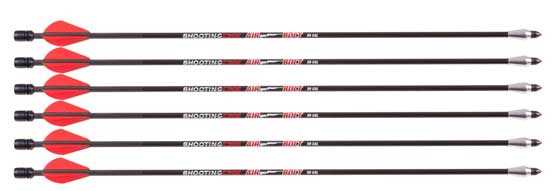
Air Venturi Air Bolts turn a .50 caliber big bore rifle or shotgun into an air bow.
This report covers:
- Like no other!
- Another air bow?
- Is the Air Bolt any good?
- What I was told
- We begin
- Muzzle-loaded
- Shot 1
- 30 yards
- Great air conservation
- Evaluation
Today I start looking at the Air Bolt from Air Venturi. This product is a package of 6 arrows that sell for $120.00 at Pyramyd AIR, and I know there will be lectures on the cost of crossbow arrows today. Because that’s what the Air Bolt is — a crossbow bolt.
Like no other!
HOWEVER — and this is the news today — with the Air Bolt, you don’t have to buy another gun. If you already own a .50 caliber big bore airgun — and hundreds, if not thousands of serious U.S. airgunners already do — there is nothing more to buy. You have everything you need to begun shooting.
Does that mean that this bolt works in a Wing Shot air shotgun? Yes! I am testing it in a Sam Yang Dragon Claw 500cc rifle which will be important to know later in today’s report.
Another air bow?
The first thing I thought when I was told about this product is — oh, boy — another air bow! We don’t know yet what to do with them, as they are not yet legal for hunting game in the United States. You can hunt hogs and other pests with them, as there are no laws governing the guns used for pests, and you can hunt game on exotic game ranches because they do not come under the state fish and game laws. But for taking the whitetail, blacktail and mule deer that are the most common game animals in this country, they are not yet legal.
Crosman, who brought out the Benjamin Pioneer air bow earlier this year, is actively working to change the game laws and get air bows legalized. But it’s an uphill battle. Not only do they have the various state governments to contend with — there is also strong opposition from the archery community. Archers don’t want to see air bows considered equal to conventional bows. But it’s worse than even that.
The archery community is itself split into numerous warring factions. Longbow users dislike crossbows who were their greatest enemies before the air bows came along. Now they find themselves begrudgingly aligning with the crossbow camp against the air bows. This factional war is very much like politics in the middle east, with camps aligning for some purposes while maintaining their distance for others. I used to think airguns had a lot of special interest groups, but we are one big happy family, compared to archery!
This situation will take time to resolve, yet there are many shooters who could not care less. They don’t plan to hunt with the air bow — they just want one in case they ever need to. That is where the Air Bolt comes into play. With the Air Bolt you can own a big bore air rifle that is legal for deer in 6 states already, with more on the way. And, just by buying the Air Bolts, you suddenly own an air bow. too. But — it is any good?
Is the Air Bolt any good?
That is my challenge. To discover for you whether the Air Bolt makes any sense. Is it accurate? Is it powerful? Is it a product you should consider?
What I was told
When Pyramyd AIR sent me 12 Air Bolts to test for you I was told they are a 430-grain field point (meaning not a hunting-type broadhead) that exits a Sam Yang Dragon Claw at up to 500 f.p.s. I was also told to expect to shoot some Robin Hood shots (where one arrow goes inside another because it hits at the same place) at substantial yardage. Those two things caused me some concern.
I asked Pyramyd AIR to send me 12 Air Bolts to cover the lost and damaged ones I expected to have. But a greater concern was the backstop. What could I get that would be strong enough to stop an arrow weighing 430- grains and traveling that fast? No crossbow in the world comes close to that kind of power! In fact, when I went to the archery store to buy a backstop they were amazed when I gave them the specifications. They had nothing that was made for that power level. So I just bought the strongest backstop they had, which is rated to stop arrows traveling up to 400 f.p.s. and hoped it would do the job.
We begin
I went to Otho’s house to test the Air Bolt the first time. He has a shooting range with a dirt berm that would stop the arrows if they passed through the backstop. I filled the Dragon Claw to 200 bar (2900 psi) and commenced shooting from about 10 meters. I didn’t want to miss the backstop and I was shooting with open sights. It turned out that the arrow hit the bag on the first shot and for all 30-40 subsequent shots fired on this day. Hitting the target wasn’t a problem.
Muzzle-loaded
The Air Bolts are loaded from the muzzle, so of course the gun is uncocked when you load it. I had a little difficulty fitting the tail of the bolt into the barrel until I wet the o-ring with saliva — the fit is that tight.
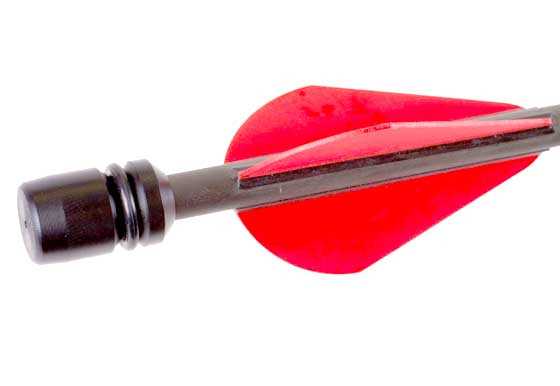
Air Bolt tail is almost .50 caliber, and contains an o-ring that seals the bore.
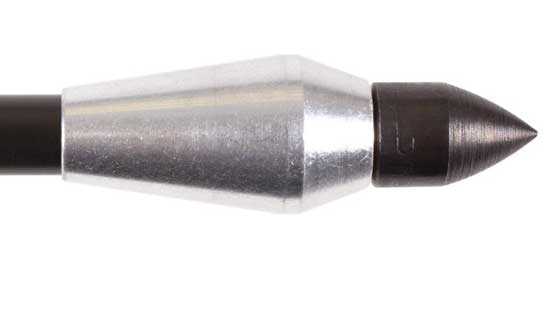
Air Bolt point is also nearly .50 caliber, and rides on the top of the rifling.
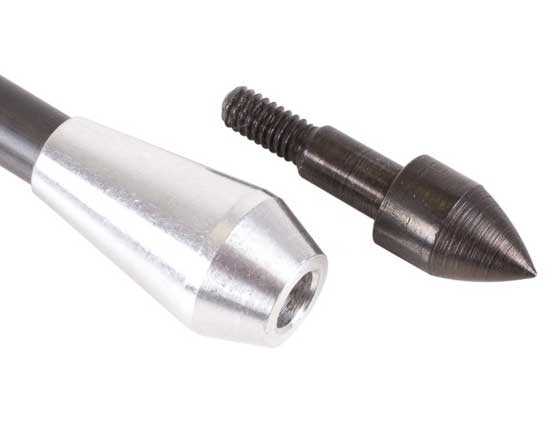
Air Bolt field point unscrews, allowing broadheads to be attached.
Once the shaft started down the bore it was easy to reach the bottom. A little of the point sticks out of the muzzle when it is loaded. I imagine with different rifles you might need a short ramrod if the barrel is longer than the 21.65-inches of the 500cc Dragon Claw I am shooting. I also imagine that barrels much shorter will not work as well, since the arrow head won’t be supported.
Shot 1
I fired shot 1 on low power to keep the arrow from passing through the arrow backstop. I needn’t have worried, though, because the arrow stopped easily inside of 8 inches. It seems the large head slows the arrow down very effectively. Also, it was very easy to remove from the backstop. Problem solved and time to back up to 30 yards.
30 yards
At 30 yards Otho and I both tried our hands with the Air Blot. We discovered that on high power the arrows dropped about 12 inches at 30 yards. They also went sightly to the right. We both shot several times offhand to become familiar with the operation of the Air Bolts.
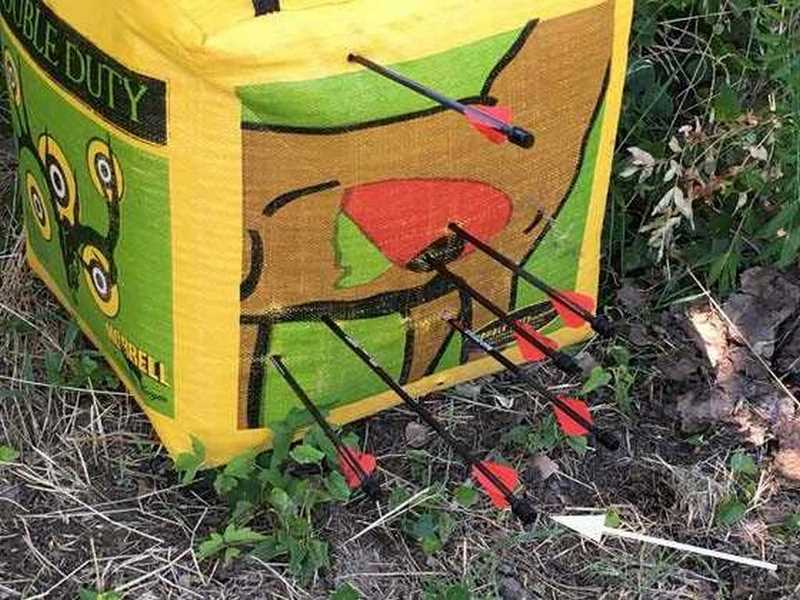
We shot from 30 yards offhand to become familiar with the operation of the Air Bolts. The arrow that is the least deep in the backstop (arrow) was shot on low power from 10 meters.
Once we were familiar, Otho tried a shot by aiming off the amount we now knew would place the arrow where he wanted it. It struck the center of the heart/lungs, which is a perfect deer shot for an arrow.
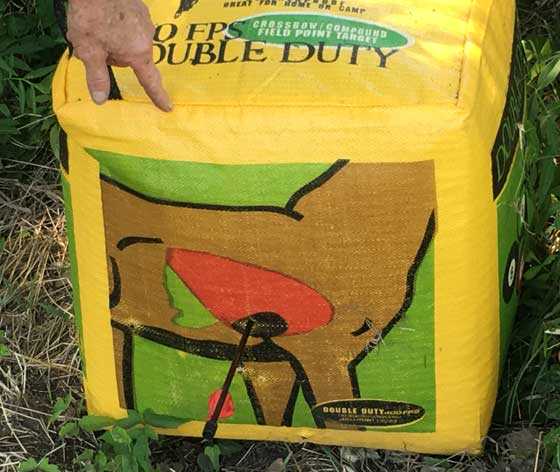
Otho put one into the boiler room from 30 yards by aiming off a precise amount. He points to where he aimed.
Great air conservation
By this time we had fired 20 to 30 shots between us. I was impressed by how many shots I got on a single fill of air. That 500cc air supply really comes into play with Air Bolts! So I topped off the rifle at 200 bar according to the onboard gauge and tried 5 consecutive shots from 30 yards. I shot offhand supported, which means I steadied the rifle against a tree. I aimed off to hit the critical kill zone of the deer on the arrow stop face.
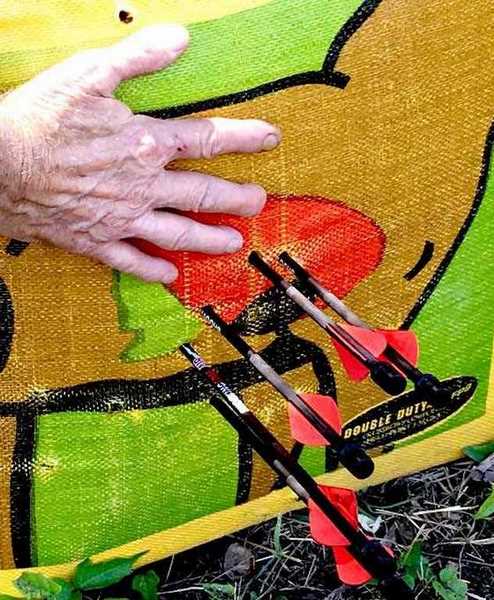
This is a 5-shot group I shot offhand supported from 30 yards. I didn’t see each arrow land, but it looks like they hit the mark with the first 2 shots and then started hitting lower on the target.
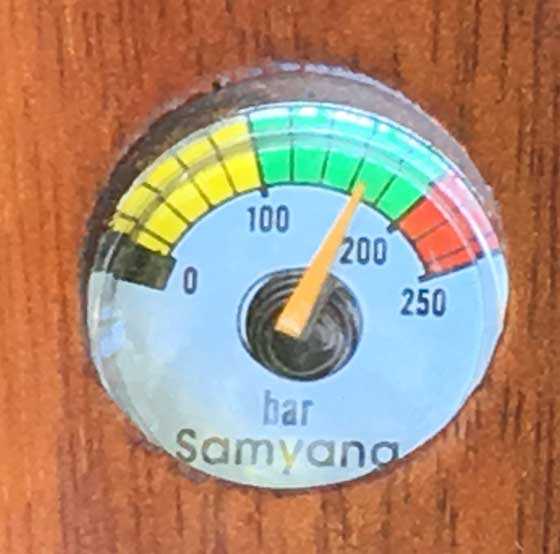
After 5 consecutive shots on high power the gun’s air pressure has dropped from 200 bar to about 160 bar. The arrows are hitting the target lower at 30 yards.
Evaluation
Today’s report was different from what I usually do. It had to be, because this product is different and I had to learn how it works before I could say anything about it. Obviously this is not an airgun I can chronograph in my office. Like a big bore air rifle, the Air Bolts have to be shot outdoors, with some thought given to stopping them.
Pyramyd AIR has started testing the Air Bolts with broadheads. They used 100-grain Rage Chisel Tip 2 broadheads and three shots out of three passed completely through a backstop target bag that is as rugged as the one I am using. Broadheads are the tips that can’t be stopped. Tyler Patner reports putting 3 arrows with them into about 1.5 inches at 30 yards. They struck the target a couple inches below where the field points did, but you adjust the sights for that.
This product seems to be beyond a regular air bow, because it does not require you to buy a new gun and because it allows you to get double duty from your .50 caliber big bore. The only thing that would make it better is if the product could be caliber-selective, where you buy the shafts and ends separately. Then you could also have .45 caliber Air Bolts. There are a lot of .45 caliber big bores out there!
I plan to conduct a “normal” test, now that I know what to expect. I will mount an optical sight on the rifle next time.

Sounds exciting.
A air gun that can be air bow, a bullet shooter or a air shot gun. Thats a versatile gun.
Oh and BB. I thought the Wing shot was a smooth bore that has a screw in choke that can now be had with different chokes. But no rifling in the barrel or choke.
The Wing shot is smooth bore right? The Dragon claw is rifled. Correct?
And I like the idea that a broad head can be screwed in place of the field target tip. And I do like your idea of it should of been designed with a removable ends to be able to be used in different caliber air guns.
I think this would be a good choice for a survival gun. The Wing shot that is using the 3 different projectiles.
Oh and how loud is shooting arrows compared to the bullet or shot shell out of that gun? And how many times do you think one arrow could be shot before it needs a new seal peice on the tail of the arrow where the nock would go on a normal arrow?
I know a lot of questions but I think it would be helpful if you can give some answers please.
Gunfun1,
If the the Wingshot is a smoothbore and has a threaded tip it could be a good candidate for experimentation for smooth twist barrels. Instead of screwing on a choke you screw on a short length of rifled barrel. If it works by increasing the accuracy of the slug then it becomes a very versatile airgun.
Siraniko
Yep I mentioned that in the past. My idea was to have the screw in pieces to have different twist rates so you could optimize the spin for a particular bullet or slug or pellet.
One thing that was brought up when we talked about it was by Reb. He suggested that the threads would have to be the opposite way of the rifling. That way the rifling wouldn’t unscrew it when the projectile hit it.
That could be another thing that could be done to the Wing shot also. Would be a pretty tunable air gun if the rifled screw in inserts would be added in different twist rates. I know they only had the one size choke available for the shot shells when the Wing shot came out. Now they offer tighter ones. So just maybe they might pick up on this and add the rifle twist inserts in different twist rates. I would like to see it happen.
GF1,
As near as I can tell, the discharge sounds the same as shooting a bullet.
B.B.
Thanks BB.
I’m imagining an aluminum barrel sleeve that is available in various lengths allowing the maker to stick to one particular length of bolts. If the bolts were only 12″ in overall length then you would need a 10″ sleeve behind it for 21″ barrel or a 22″ sleeve if you have a 34″ barrel. Adjust length of sleeve accordingly to length of barrel.
The .458 caliber bolt seems very doable.
Broadheads are heavier which would answer the greater drop in height from the aiming point compared to the field points. It would probably require a higher power output to achieve more distance.
Siraniko
And that sleeve your talking about could be held in at the muzzle end like the choke is now. Heck you could even shoot different caliber bullets or pellets out of the same gun. A .50 caliber barrel is basically a .500″ or half inch inside diameter. I could see a sleeve that screws into the muzzle that goes down to the bolt of the gun. It could be made to shoot .177 caliber pellets and anything inbetween up to .50 caliber. And it could be smooth bore inserts for the barrel or rifled insert for the different calibers available.
Man just think. A .50 caliber bullet or a .177 caliber pellet or next a .30 caliber JSB pellet. Take the sleeve out and you can shoot the gun as a shot gun or arrow shooter.
Definitely would like to have all that available rather than that Beeman double barrel that shoots two pellets at once. 🙂
Hey wait a minute I just described the Air Force guns as to how the different barrels could be changed.
Darn to bad Air Force didn’t make a .50 caliber barrel. Bet that would of been a nice addition to the Escape survival line of guns. Then you could of shot arrows also or the shot shells.
Maybe Air Venturi will catch on and make different caliber arrows. Or the different size screw on pieces like BB mentioned. I’m already thinking there is more to come on this arrow and air shot shell stuff.
It would be easier for them to make/supply a .50 cal smoothbore barrel to allow air bolt use on their complete line. Doesn’t have to be steel it could be made out of aluminum or brass.
They do not really want a smoothbore for these as the fletching is straight and does not impart spin to the bolt. The rifling does such. They will work with a smoothbore, but they will be less accurate.
Rifling initially allowed overbore balls to be stuffed down the muzzle. This had the dual effect of ensuring constant contact with the bore and of imparting spin, and thus stabilization, to the now oblong bullet. Spin is necessary to keep a non-spherical bullet from tumbling.
None of that applies to an arrow. Helical fletching *might* impart enough spin to help in the whole process of ensuring proper balance in flight ,but there’s not enough evidence to demonstrate that it does.
Honestly, the excessive contact between the fletching and bore is eliminating any possible positive impact from the rifling. I get similar groups with my compound at 30, and can’t shoot to the same point of aim at 50 with my crossbow. If I did, I’d just be destroying arrows.
Considering what BB considers acceptable from a .22 airgun, and the fact that I can’t come close to matching him, his results from 30 with the arrows indicate a major problem with the concept.
Josh,
Welcome to the blog.
Let’s hold off on our opinion of the accuracy until I get an optical sight mounted. If this thing can Robin Hood, I think that’s good enough.
B.B.
Josh
The product truly deserves an optic to see the accuracy potential. At 30 yards with a 9x scope, I was able to produce two groups in a row, one at 1″ and the other at 3/4″ at 30 yards. I’ve destroyed multiple bolts at this point because of bolt on bolt contact on target.
We’ve seen what helical vanes can do with the Pioneer airbow, they certainly work well enough to stay with or better very high end cross bows. We’ve taken high speed footage of both the Airbow and Air Bolt’s, and I can assure you, they spin just fine.
If you’re interested, check out the video we posted on it a few days back and see the results for yourself.
/airgun-video-details/Pyramyd_Insyder_Air_Bolt_Review/366
Straight vs helical fletching:
Seems to me that straight fletching would be resisting rifling induced spin, no?
For best efficiency, would the fletching require some special angle to better match whatever spin the rifling created?
Seems some experimenting might be informative.
My thought is that enough contact is created between the fletchings and nock to impart the right spin on the arrow. My initial experiences with the Air Bolt were quite interesting as I can recall many times feeling the bolt twist in my hand as I pushed it down the bore. So this meant that something was catching the rifling and reacting to it. My money would be on the nock doing that.
The folks that make the Air Bolt know their stuff when it comes to arrows and archery in general. It is my understanding that they did extensive testing with the Dragon Claw to get the performance they wanted. I would bet straight vanes were selected to aid in the speed department because they already had the spin they needed, created by the barrel itself. I’m just speculating on that, but again, that’s where I would put my money.
Hi Tyler,
My remark was meant to address the bolt in-flight, with the existing spin, however it was caused, being resisted by fins set at 90 degrees to the rotation.
The oncoming airflow (apparent wind, in sailing terms,) is coming at some angle which is a combination of the shaft rotation, and the forward motion. It seems to me that there should be an ideal angle for the fletch to enter this flow, …and it doesn’t seem intuitive to me that the angle would be 90 degrees to the rotation.
I don’t doubt that the designers know their stuff, but this question remains unclear to me.
I appreciate your hands-on comments, because I have no experience with any bolt-firing gun. ( I’m an old recurve kind of guy 😉
Have been shooting crossbows for 20 years. Currently shooting @ 420 fps.
X-bow bolts do not retain velocity like arrows from a compound. The shorter bolts do not buck the wind as well.
For best accuracy use good mechanical broad heads with very sharp blades. These can only be shot once before sharpening or replacing the blades. Two or three blade makes no real difference.
I use two blade ones that snap open to over 2 inches. I have dropped 17 whitetail with these and they rarely move from the spot where they are hit.
50 yard shots on deer do not generally work because x-bows are so darn loud
I keep my shots to within 35 yards so the deer won’t jump string on me.
griffon,
Welcome to the blog.
B.B.
Siraniko
It would be easy. The tube as we are calling it would have to stepped down in diameter for use in a Talon or Condor though. The barrel goes through the striker. That would seal the air flow as normal. And wouldn’t need to worry about loading a pellet back there because the arrow would still be loaded at the muzzle of the barrel. The Condor and the Talon’s have pretty big outside frame diameters where the barrel fits. So it would be very easy to make a stepped down tube of .50 caliber size and the collar’s to hold it in place in the Air Force gun.
I would like to see it happen. I think it would be a great addition to the Escape line. I could see them using the Condor SS as the gun because it could accept a longer tube for the arrow to go in. Then all they would need was the smaller hi-flow bottle like the Escape uses. Then you could also still use all the other barrels Air Force offers for their .25 caliber and smaller caliber line of guns.
But they could just stay with the frame that the Escape uses now. The tube would just stick out of the frame kind of like how a regular Condor looks with a long barrel. I think it would be good if they offered it. Heck someone could even shoot .50 caliber round balls or bullets out of the gun. You would just load from the muzzle end. But the tube really should be made out of steel I believe.
Sounds like a fun gun to me. Probably wouldn’t shoot the round ball very fast. Heck a 100 grain bullet at 500 fps will still do some damage.
GF1,
You lost me on some of that,….. but I am wondering if a big bore would require a different valve to do more of a massive dump of air?
Let’s say I put a .50 on the .25 M-rod. The valve may not dump enough air all at once for an arrow or .50 bullet to work properly. That is kind of what you are talking about with the Air Force line. Just because you do a barrel swap,… would the valve be up to the task?
I do not know,… just thinking. You have messed with that stuff more than I.
Chris USA
Pretty much so a bigger valve would be needed.
The Escape series Air Force guns do use a a higher flow valve than their other guns. But not as high flow as the Air Force Texan big bore.
The Texan is making big time power. So I was thinking a lower power .50 caliber Escape. If it could shoot a 100 grain ball at 500 fps that would be around 55 foot pounds of energy. That’s probably about what your Mrod is making with the . 25 caliber JSB 33.95’s. But now double the diameter size of a .50 caliber round ball making 55 foot pounds of energy. That big .50 caliber ball is going to put a hurt”n on whatever it hits.
GF1,
That is the advantage with the arrow (over) barrel design. The air space in the barrel must be filled first, that is a down side. A smaller barrel is a plus. The 880 barrel was perfect for an aluminum arrow.The spine/shaft flex should be much less too. But still, would a standard valve be up to the task?
It seems that both types of products are fulfilling a specific need. Depending on the model of gun,… barrels and arrows for an easy swap would be the next thing I see coming. I am talking arrow over barrel there now.
Chris USA
And forgot. That 500 fps probably could be had with a 100 grain .50 caliber ball with a smooth bore. The rifling would add extra resistance to the ball. Well I guess that all depends on the fit of the ball to the rifling. If the ball was a loose fit and rode only on top of the rifle lands that would maybe be less resistance than a smooth bore barrel. One way or the other the fit of the ball would make the difference in velocity.
GF1,
A .50 caliber ball that only weighs 100 grains? Is it made of wood?
B.B.
BB
Well maybe it would CV weigh a little more. But you get the idea.
/ammo/pellets/pt_6/calibers_0_5
I have been seeing others including Tyler Patner and Jim Chapman who have been testing these. They are really quite impressive. The Dragon Claw or a rifled barrel will perform better with these as the fletching is straight and will impart no stabilizing spin to the Air Bolt. I am very interested in seeing how far a good hunting group could be achieved, say 3-4 inches.
GF1 – The Wing Shot is a smoothbore. I like the idea of the screw on rifling tip. The rifling would indeed have to twist in the opposite direction of the threading though. If Air Venturi should develop a rifled choke for the Wing Shot I am certain it would become a huge seller.
RR
I agree. They should at least offer the rifled screw on tips for people that would want that option in the same gun that could shoot a shot shell or their new arrows.
GF1,
I got up last night around midnight and took a flashlight and looked out at the squirrel bait station. 5 sets of eye balls lit up! Coons. Up at 4, I looked again and saw a coon up on it’s hind legs going after the suet block real hard. He got about 1/8 of it. All the shelled corn on the ground was gone and anything left on the ears were gone as well. The 2 ears on the tree are getting picked at slowly.
I should say 1 1/2 ears on the tree. I took a 33.95 and shot 1 of them in half clean as can be. Corn went flying all over the place. A new way to shell corn off an ear? 😉
Will be doing the silicone and striker 1/2 turn later and make up some targets. May get out, but maybe not. Almost 90 and high humidity.
Just an update,….. Chris
Chris USA
Ah now you see why I like shooting corn cobs long distance. They don’t just make a hole when hit with my .25 Mrod. They explode. 😉
And ok I really want to know if that helps your Mrod. The 1/2 turn in on your striker is going to make a difference I think. I really think that it wasn’t hitting the valve stem hard enough with the o-rings in place.
The way your striker and hammer work now with the o-rings. Is you need to adjust the striker in deeper to get farther past the o-rings. That will up your velocity with that kind of anti bounce set up.
GF1,
Did the silicone, 1 drop. I was surprised to see a bit of a “felt?” “filter” in the nipple,.. when observed with a flash light. It still looked quite “wet”, even after the fill.
Also did the 1/2 in on striker. Before doing so,.. I checked the current setting and it was still at 2 in. So,.. the Loctite held.
Tomorrow is iffy,… so it may be Thursday,…. we shall see.
Looking forward to running it through it’s paces at 70 yards.
Chris USA
Ok for sure let me know how it goes whenever you get to shoot it again.
B.B.,
If you watch the P.A. video, they use some silicone oil on the tail end and the fletches’. They also show rolling the fletches’ over onto themselves and then starting the arrow down the barrel. In a rifled bore, I imagine that what direction you roll the fletches’ might be a consideration. In the video, the back of the head rest against the muzzle and acts as a bit of centering device.
Another thing to consider different length barrels. On a shorter barrel, the arrow would be fully bottomed and receive the air blast immediately. With a longer barrel, that air blast would (first have to fill an empty section) of the barrel. I could see that affecting fps of the arrow. From the report, it appears that the alum. tip holder will go down the barrel.
Question: Is that the case?
If so, then the air gap at the rear would be a mute point. With a broad head and longer barrel however, it would become a factor.
Nice testing and looking forward to future reports.
Chris
Chris
You need a 22″ barrel at a minimum for it to work properly. I’m working on tracking down something to test the shorter barrel with. But I suspect because there is no support for the aluminum insert at the front, consistent accuracy would be hard to achieve.
And yes, the direction you fold/roll the vanes does matter. I recommend clockwise, but so long as you are consistent, your results should be quite consistent.
Tyler,
Thank you for that. So would the aluminum tip holder go into a longer barrel? Or is it too big?
I like the idea of the air hitting the back of the head better,….. but,… you can not argue with the accuracy that these are getting,.. not to mention that added versatility that it gives a .50 owner.
Chris
No, the aluminum insert is not meant to go into the barrel. So if you had a 26″ barrel, you would be looking at a 4″ gap from the breech end of the barrel, to the back of the nock. I doubt this would change performance significantly. The amount of air that gets behind the bolt is really what would be the biggest factor. With some of the custom shop and smaller manufacturers out there that make more powerful .50’s, I think we could see some astonishing numbers. Whether accuracy or the bolts in general can hold up at higher speeds would be the interesting part.
If nothing else, and let’s put legality aside for a second, these are just plain cool. The versatility (to your point) is one of the biggest selling points. And heck, as a compound bow shooter and an airgun owner, I do think it has a place out in the field. I’m just not sure where that is. But what I do know is that these types of products make it almost impossible to ignore the fact that Airguns can get it done just as well as most other traditional hunting methods. The more people realize that, the more widely accepted airguns will become, particularly for hunting.
Tyler,
Thank you, you answered that very nicely! 🙂
Chris
B.B.,
I would be interested to know the F.O.C. (front of center) point in relationship to the measured center. It is easy to check.
1) Measure the overall length of the arrow. Mark the center.
2) Balance the arrow. Mark that point. (this point should be ahead of the center mark)
3) Measure the distance between the steps #1 and #2.
For a 28″ arrow, with the balance point 2″ ahead of the measured center,… you would figure as follows,….
2″ divided by 28″ = .0714 x 100 = 7.14 (This is your F.O.C. %)
For field points, this should be 8~11%
For broad heads, this should be 10~15%
Thanks, Chris
Chris,
Okay. I can do that.
B.B.
B.B.,
Thank you. That will be interesting to see. From having messed with this myself,… design aside,…. a lot of deliberate effort was put into (weighting) the front and rear pcs. to achieve that ratio.
Chris
Gee, this looks very interesting! However, big bores are not freely available in my country (South Africa) and would probably be restricted by our very strict fire arm legislation.
BB, would .22 Air Bolts be practical (if Air Venturi would produce them) if shot from a powerful PCP like a .22 Sumatra 2500?
Vasco,
I think a lot of thought would have to be given to get .22 caliber bolts to work.
B.B.
Make sure you use (or modify) an air gun to pcp very high air pressure then mount a steel brake line that fits inside the largest crossbow arrows you can buy. Take the back end off the arrow then slide arrow on to the brake line, shoot, and smile! I converted an old paintball gun with a brake line but it would not produce enough pressure for that small a tube with arrows only traveling only about 10 meters. (I may revisit that and see if I can modify it to much higher pressure) The idea does work if the pressure is high enough, is hugely cheaper than commercial arrow launchers, and should take care of your needs quite nicely! google address +tinkerbill
BB what does the gun look like?
Mildot52,
Click on the link for the rifle and you will see.
B.B.
B.B.
For field-points a canvas bag stuffed (tightly) with plastic bags (the thin bags that they use at grocery stores work best) makes an excellent weather resistant target butt that stops arrows well and allows then to be removed easily.
I usually suspend the bag so that it can’t roll over and damage the arrows.
The best backstop for broad-head is medium density ethafoam. Thickness of the backstop depends on energy levels – ideally, the arrow point should penetrate through the foam but the fletching doesn’t touch it. For my hunting bows, three 2″ sheets of ethafoam does the trick. I “pin” them together with wooden dowels.
I blunt the edges of the blades and glue them in place with Cyanoacrylate to make them safe and durable.
I suggest removing the broad-head before trying to extract the arrow from the foam. A piece of rubber sheet (from an inner-tube) works well to help grip the arrow shafts for removal.
Hank
Guys,
Just got my copy of FIREARM NEWS which has two articles written by…drum roll… the master, Mr Tom Gaylord, one is about the Hammerli K31 Training Device. The pictures accompanying the K31 are excellent.
The other is about the Swedish Excellent, a mulpi-pump rifle.
The pictures of the K31 alone are worth the trip to your local magazine emporium.
Bruce
.
Bruce,
Thanks for the heads up! I haven’t received my copy yet.
B.B.
For the Lilliputians, …a trip into fantasyland:
How far can this concept be taken, miniaturization-wise?
If the market could be expanded to those of us who own smaller bores (.22, let’s say), considerably more bolts might be sold, no?
The math says an 83 grain bolt at 2900psi/500fps would use one fifth (19,35%) of the air used by the .50 cal, …would have the same force accelerating the bolt (1.32 lbs. per grain), …would have less than half the o-ring friction (44%), …and give a muzzle energy of 46.07 ft/lbs, vs 238.66 for the .50 cal.
If an 83 grain bolt w/an effective broadhead could be produced, do we really need the .50’s ability to shoot thru 3 or 4 deer in a row? 😉
(…and targets would be able to stop our target-tipped bolts much more easily.)
Thoughts?
forgot to specify-
Equal length barrels (same accelerating force (pounds-per-grain) applied for same time/distance,) gives equal velocity.
Oops, …further thought-
less o-ring friction (.22) means less total resisting force vs accelerating force’
Thus greater acceleration. .22 should be faster than .50, if barrel extended to give equal force-application time (time in barrel).
Corrections welcome.
CBS,
I like your math. The arrow over barrel concept would be best for small bores. I am thinking pistols with a good size air chamber and a high dump valve. Maybe 2-5 shots at best. At a 100 grains per bolt/arrow,… that might work. PCP of course and purpose built. I do not see anything existing that would do that.
ChrisUSA,
If we want a nice round figure of 100 grains for the bolt, maybe the decreased air resistance of the smaller-than.50 cal bolt, along with the greater muzzle velocity I suggested (because of less o-ring friction) would make up for the additional weight of the 100 grain bolt over the 83 grains I specified in my math. Flight trajectory should be better(flatter) than the .50 cal. Let’s assume carbon-fiber( very small diameter) bolts.
Our accuracy is going to be so good, we will have to use multiple target faces for our shooting – to prevent Robin Hood damage to our expensive bolts!
CBS,
With small bore, the arrow would have to go (over) the barrel. No need for a (“very small diameter”). You need the fletch’s for stability. That will NEVER happen cramming them into a .177 or .22 barrel,… or even a .25 barrel. Plus, you have to maintain a good degree of spine/shaft stiffness.
Hi again Chris,
No offense, but words like “have to” and “never” always get my eyebrows to go up in a “Oh yeah?” response. 😉
I used the word “miniaturization” awhile back, and thinking in those terms, I see an *appropriately sized* fletch being as easily crammed into the .22 bore as an equally appropriate sized one into the .50.
We are entering the nano-age, these days, so maybe we can discard some of our previous limitations while here in Lilliput. If (IF!) a vsd shaft of appropriate material/spine could be made, the surface drag during flight would be considerably reduced, compared with the extant .50 bolt. I mean the surface or skin drag of the shaft itself. Remaining drag, of the broad head, the fletching, and the bore-filling o-ring receptacle are separate issues, …2 of the 3 being geometrically certain to have less form/profile drag than the .50-size, except for that of the broadhead, which presumably has some minimum size/weight that could be equal in both calibers.
I see the design of the shaft itself being problematic, as a less-than bore filling diameter would leave side-to-side up-to-down motion possible during launch, and some course-altering sway could be introduced given that there would be no guidance to keep the shaft aligned with the trust from the rear. ( I am assuming there would be some bore-filling contact at the arrowhead/muzzle juncture to keep the shaft in alignment until the trigger was pulled.)
I think we would have to hope that the milliseconds of launch would see the missile on it’s way before any “sway” could begin, …thus the fletching-stabilized flight path would be established with things still aligned. The broadhead/field-tip mass should help some due to it’s inertia, with the initial force being applied thru the stiff shaft directly in line with the bore, …this would be the only or main force acting at the time, influencing the head to move straight ahead until the fletching added it’s influence to keep the tail following obediently, and the rifling-induced spin evening out any sway tendency.
We should keep the old adage in mind: ” In theory, both theory and practice are the same, …but in practice, they’re not!”
But that does’t make theorizing any less fun 🙂
Thanks for the thought-provoking.
CBS,
Very nice. I have not seen you here before that I re-call. We “here”,… get off on “theorizing tangents” from time to time,… (that might be understated),….. a bit,…. 🙂
Please come back.
Chris
Chris and Tyler,
To continue the theorizing re. straight vs helical fletching Tyler and I have been exchanging:
It seems to me counterproductive to INDUCE spin (by whatever means) and then REDUCE spin by having fins directly oppose it.
Helical fletching on arrows shot from bows serve at least two functions, – to induce stabilizing rotation I(desirable for its “balancing” or evening out of any forces tending to swerve the arrow from its course), and to create drag which prevents the yawing which would slow and divert the arrow (i.e., it keeps the tail following the dog.)
So, it seems to me, we would want an angle of the fletch which would minimize resistance to rotation, and a minimum size of fletch which would provide only-sufficient drag to keep the tail in its place. ( …any size in excess of that actually required would only serve to slow the missile we have gone to considerable design-trouble to accelerate.)
So, …fletching design goals:
SMALLEST (therefore lightest) effective size for just adequate drag ( and maximum cramability 😉 ,
ANGLED to best minimize resistance to the apparent wind
= fastest best-stabilized arrow/bolt.
Disagreement/corrections always welcome, …let’s keep learnin’ 🙂
CBS,
I can not dis-agree with any of that.
“cramability”,…. I like it. It does seem a bit “caveman” though. How about?,…. “ease of insertion”?
Too sexy.
If we hafta be hi brow, we’ll just say it “facilitates loading”.
But I call “Profiling!”
Just because my real name is Zog, you think I’m a caveman? Sheesh!
Are we haven fun yet? 🙂
Oh yeah,…. Thank you as well for the “thought provocation”! 😉
CBS,
I did exactly what your proposing by modifying a paint gun and installing a steel brake line as the inner barrel. Make sure to use crossbow arrows that fit the brake line snugly but should still slide freely. My only problem was I needed more air pressure than the paintball gun could produce. See my reply to “Vasco” for more info.
A very good blog with so very many good comments.
Persuading law makers to allow the airbow and the air bolts for hunting “game” animals will likely take some time. And just as likely to take a large enough group of people pushing for it. I don’t know that Crosman or any company can accomplish this without air archers working toward it.
Traditional long bow and compound bow shooters worked to get a separate season. Later, they resented crossbow shooters attempting to be part of “bow season”. The editor of Bow Hunter made this clear to me in the later ’70’s.
I believe the accessory rail on the Pioneer is perfect of a crossbow prod and anchoring point for the string. It isn’t a spring piston (which I think is most like a crossbow) but it makes it clear in my own mind that it is a similar and efficient bolt (arrow) launcher. As was true of the crossbow, the air bow and air bolt may become legal for game hunting during the regular gun season first, provided some law makers choose to look at the facts. The only barrier will be politics and the aforementioned warring camps of archers.
~ken
Paradox?
New question: How might slow-motion studies of an bolt/arrow shot from an air-bow compare to slow-mo studies of an arrow from a “standard” bow re. “Archer’s Paradox”?
The bow-shot arrow reacts to the thrust of the bowstring/ the inertia of the arrow head/ and the (usually) off center arrow rest, with a “wiggling “flight not usually visible to the eye, but readily so on film. This is interesting when the fletch-induced spin is considered, i.e., How does the arrow seem to maintain its wiggle in a more or less constant plane while it is rotating, …or DOES it? Is the “wiggle” rotating?
Does anything similar occur when an air gun bolt is launched with the thrust hopefully centered through the shaft, or is the flight a smoother wiggle-free flight?
Anyone know of any slow motion AirBow bolt-flight videos?
CBS,
I believe Tyler mentioned that they have “slow-mo” filmed that. Go back and see.
I still like the air blast hitting the back of the head better. Like on the Pioneer. That would eliminate a lot of what you are talking about.
You got a coffee I.V. drip going there? 🙂
Chris USA,
No coffee, just hurrying’ to get some fun in before errand running, gotta go soon. Nicetameetcha!
Force(air blast) applied over time, = acceleration
Not familiar with Pioneer. How long can force be applied to “head” if head exits barrel first?
How long must barrel be if there is to be a longish force-applied period? How long is bolt?
Don’t understand . I can’t discuss the blasted-head concept intelligently, …too ignorant of the subject.
Gotta go for now.
Best wishes to all!
That group is worse than I typically do at 30 yards with my compound bow — offhand and UNsupported, and of course no optics. So these things are not terribly accurate.
Broadheads kill via hemorrhage, not hydrostatic shock. Once you’ve gotten pass through, you’ve done all you can do. You don’t need more than 50fpe or so to pass through any North American game animal. 430 grains @ 500fps is 238 fpe (!!!) Serious overkill.
The extra fps does minimize holdover. That’s about the only ‘plus’ I can find.
A truly odd product. A solution in search of a problem.
ContrariMN,
Welcome to the blog.
As I mentioned in the text, this was just a test to see what the fall-off might be of 5 shots at max power. I don’t recommend shooting 5 shots on max power when hunting, though you are very unlikely to do that.
There is a lot more testing to be done. This was just familiarization day.
B.B.
BB— I just ordered the Diana Mauser 98K from P.A., in .22 cal. Its advertised velocity is around 800 fps. At what velocity will .22 cal pellets lead the bore? Thank you, Ed
Ed
This gun? I like it. Alot.
/product/diana-mauser-k98-air-rifle?m=4164
Ed,
Leading differs with each pellet’s alloy. But after 850 f.p.s. it starts to become a problem and after 950 it’s almost a certainty unless the bore is ultra smooth.
B.B.
GF1–I have been collecting and shooting millitary trainers for 50+ years. I appreciate being able to shoot air gun replicas in my basement and backyard. Thats why I like my Gletcher m 1944. However, there is a big boulder and a rock wall in my back yard. Lead pellets are no problem, but I have to be careful when shooting bb,s. Now that I put a real Mosin Nagant front sight on the 1944, I have to use the 700 yd setting for a 10M zero. The heavier lead shot would require a higher rear sight setting, so I shoot steel bb,s where they cannot hit a rock. I hope that the 98K will not have a lead fouling problem, because the barrel can only be cleaned (with a rod) from the muzzle. The specs give a velocity figure of 850 fps. At what velocity will .22 cal pellets lead the bore? Ed
Ed
No idea on the leading but I sure like the gun. It’s definitely on my want list. And not a bad price at that. It does say a hardwood stock whatever that may mean.
I for sure will be watching this gun how it does.